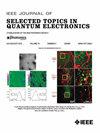Performance Metrics and Loss Mechanisms in Horticulture Luminescent Solar Concentrators
IF 5.1
2区 工程技术
Q1 ENGINEERING, ELECTRICAL & ELECTRONIC
IEEE Journal of Selected Topics in Quantum Electronics
Pub Date : 2025-02-11
DOI:10.1109/JSTQE.2025.3540601
引用次数: 0
Abstract
Horticulture Luminescent Solar Concentrators (HLSCs) represent an innovative concept developed in recent years to promote crop yields, building upon the foundation of traditional Luminescent Solar Concentrators (LSCs). Unlike traditional LSCs, HLSCs focus on converting energy from one part of the solar spectrum (typically green) to a specific range (usually red) and aim for the converted photons to exit the device from the bottom surface rather than the edge surfaces. Thus, beyond spectral conversion, HLSCs are especially notable for their light extraction capabilities. Efficient spectral conversion and outcoupling efficiency are achieved by optimizing luminescent materials and introducing light extraction techniques. In this study, we start by examining the specific requirements of horticulture to clarify the motivation for using HLSCs. We re-evaluate and propose new optical metrics tailored to HLSCs. Additionally, we analyse potential loss channels for direct red emission and converted red emission. Utilizing Monte Carlo ray tracing method and experimental data, we further explore the factors influencing these loss channels. The key evaluation metrics for HLSC and LSC are compared to highlight the distinctions between the two, emphasizing the innovative features of the HLSC device. Our work provides a fundamental discussion on HLSCs and offers design guidelines for future HLSC research.园艺太阳能发光聚光器的性能指标和损耗机制
园艺发光太阳能聚光器(HLSCs)是近年来在传统发光太阳能聚光器(LSCs)的基础上发展起来的一种创新概念,旨在提高作物产量。与传统的LSCs不同,HLSCs专注于将太阳光谱的一部分(通常是绿色)的能量转换为特定范围(通常是红色),并旨在使转换后的光子从底部表面而不是边缘表面离开设备。因此,除了光谱转换之外,HLSCs特别值得注意的是其光提取能力。通过优化发光材料和引入光提取技术,实现了高效的光谱转换和解耦效率。在本研究中,我们首先考察了园艺的具体要求,以阐明使用HLSCs的动机。我们重新评估并提出了针对HLSCs量身定制的新光学指标。此外,我们还分析了直接红发射和转换红发射的潜在损耗通道。利用蒙特卡罗射线追踪方法和实验数据,进一步探讨了影响这些损耗通道的因素。比较了HLSC和LSC的关键评估指标,突出了两者之间的区别,强调了HLSC设备的创新特征。我们的工作提供了一个关于HLSC的基本讨论,并为未来的HLSC研究提供了设计指南。
本文章由计算机程序翻译,如有差异,请以英文原文为准。
求助全文
约1分钟内获得全文
求助全文
来源期刊

IEEE Journal of Selected Topics in Quantum Electronics
工程技术-工程:电子与电气
CiteScore
10.60
自引率
2.00%
发文量
212
审稿时长
3 months
期刊介绍:
Papers published in the IEEE Journal of Selected Topics in Quantum Electronics fall within the broad field of science and technology of quantum electronics of a device, subsystem, or system-oriented nature. Each issue is devoted to a specific topic within this broad spectrum. Announcements of the topical areas planned for future issues, along with deadlines for receipt of manuscripts, are published in this Journal and in the IEEE Journal of Quantum Electronics. Generally, the scope of manuscripts appropriate to this Journal is the same as that for the IEEE Journal of Quantum Electronics. Manuscripts are published that report original theoretical and/or experimental research results that advance the scientific and technological base of quantum electronics devices, systems, or applications. The Journal is dedicated toward publishing research results that advance the state of the art or add to the understanding of the generation, amplification, modulation, detection, waveguiding, or propagation characteristics of coherent electromagnetic radiation having sub-millimeter and shorter wavelengths. In order to be suitable for publication in this Journal, the content of manuscripts concerned with subject-related research must have a potential impact on advancing the technological base of quantum electronic devices, systems, and/or applications. Potential authors of subject-related research have the responsibility of pointing out this potential impact. System-oriented manuscripts must be concerned with systems that perform a function previously unavailable or that outperform previously established systems that did not use quantum electronic components or concepts. Tutorial and review papers are by invitation only.
 求助内容:
求助内容: 应助结果提醒方式:
应助结果提醒方式:


